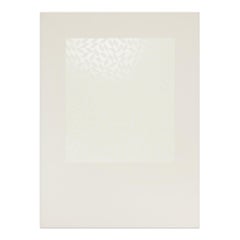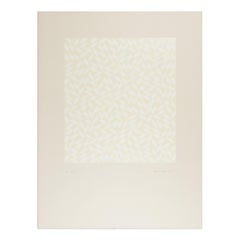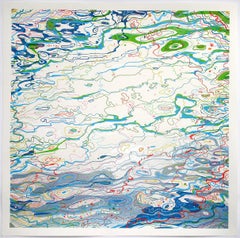Anni Albers More Prints
As mesmerizing as Anni Albers’ weavings and prints are, her art represents only a fraction of her achievement. In addition to being one of the most important textile artists of the 20th century, she was a designer, writer and teacher.
Albers was born Annelise Fleischmann in 1899 to a well-to-do Jewish family in Berlin. She studied at the School of Applied Art in Hamburg and then attended the Bauhaus, the utopian workshop founded in Weimar in 1919 by architect Walter Gropius.
The school envisioned a unity of art and design, with the goal of training designers and artisans who could create objects both functional and artistic for mass production. At the Bauhaus, where women’s choices for study were limited, the aspiring Albers ended up in the weaving workshop. Although she initially perceived the discipline as unserious, once she had a thread in hand, she was obsessed.
“I heard Paul Klee speak, and he said to take a line for a walk, and I thought, ‘I will take thread everywhere I can,’” she once told Nicholas Fox Weber, executive director of the Albers Foundation.
At the Bauhaus, Anni met and married fellow student Josef Albers, who would later become a celebrated color theorist and painter. His “Homage to the Square” paintings, which explored the relationships between colors, are now considered modernist masterpieces, and his treatment of color was crucial to the development of the Op art movement.
After graduating in 1930, Anni and Josef both became teachers at the Bauhaus, but when the Nazis came to power, the school was shut down. In 1933, fleeing the Nazis, the couple emigrated to the U.S., where they both became teachers at Black Mountain College, in North Carolina.
Black Mountain, which rejected educational norms and was known for its free-spirited atmosphere, produced many luminaries of modern American art — among them Robert Rauschenberg and Cy Twombly, both students of the Alberses’. In addition to teaching, Anni continued her own artistic practice, making what she called “pictorial weavings”: abstract wallhangings having the same formal qualities as a painting.
The Alberses were fascinated by Latin America even before they crossed the Atlantic, so from North Carolina, they made numerous road trips to Mexico and Peru to collect pre-Columbian art. The influence of the ceramics and textiles the couple discovered in their travels is clear in Anni’s work yet her approach to weaving was unorthodox.
Albers incorporated unusual materials such as cellophane and metallic thread. She intertwined linked threads in innovative ways and added knots as artistic elements, as in “Dotted” Weaving (1959). She created studies using corn kernels, grass, twisted paper, lines made with a typewriter and pin pricks.
In addition to her art pieces, Anni designed many functional textiles for mass production. In 1949, Gropius commissioned her to create fabrics for the Harvard dormitories he designed. Shortly afterward, she was commissioned to design fabrics for the furniture company Knoll. In the late ’50s, Anni began publishing books: On Designing, in 1959, and On Weaving, in 1965.
In her 60s, when it became difficult for her to operate a loom, Anni turned her energies to making prints. Beyond the increased recognition of weaving as an art form, another reason for the renewed interest in Anni’s work is that art history has now turned its lens on women artists who were previously overlooked.
Find Anni Albers rugs, wall decor and original prints on 1stDibs.
20th Century Abstract Anni Albers More Prints
Screen
20th Century Abstract Anni Albers More Prints
Screen
2010s Abstract Anni Albers More Prints
Paper, Screen
1970s Abstract Geometric Anni Albers More Prints
Paper, Screen
1970s Abstract Geometric Anni Albers More Prints
Screen
1980s Abstract Geometric Anni Albers More Prints
Paper, Screen
1960s Abstract Impressionist Anni Albers More Prints
Screen
1970s Abstract Expressionist Anni Albers More Prints
Color, Screen
1970s Abstract Expressionist Anni Albers More Prints
Color, Screen
1970s Abstract Expressionist Anni Albers More Prints
Color, Screen
1960s Abstract Expressionist Anni Albers More Prints
Color, Screen
1970s Abstract Expressionist Anni Albers More Prints
Color, Screen
1940s Abstract Expressionist Anni Albers More Prints
Color, Engraving, Etching, Screen
1970s Abstract Geometric Anni Albers More Prints
Board, Screen


